For procurement professionals and manufacturers, selecting a surface finish is a critical business decision. It directly impacts product durability, supply chain efficiency, and your bottom line. The choice between powder coating vs wet paint is not just about aesthetics; it’s about Total Cost of Ownership (TCO), production velocity, and long-term performance.
This guide is engineered for the professional buyer. Backed by real-world manufacturing expertise and global OEM application insights, we go beyond a simple list of pros and cons to deliver a definitive analysis grounded in industry standards. Our goal is to provide clarity to help you select the most profitable and reliable finish for your sheet metal components.
1. The 30-Second Decision: A Quick-Glance Comparison
In procurement and production, time is a critical resource. For a swift, high-level overview to inform your sourcing strategy, this comparison chart highlights where each technology delivers the most value for your business.
| Business & Performance Driver | Winner: Powder Coating | Winner: Wet Paint |
|---|---|---|
| Best For Overall Durability | X | |
| Best For Custom Color & Small Batches | X | |
| Best For Tight Tolerance Assemblies | X | |
| Best For High-Volume Throughput | X | |
| Best For Environmental Compliance | X | |
| Best For In-Field Serviceability | X | |
| Best For Lowest Initial CapEx | X | |
| Best For Lowest Long-Term TCO | X |
This executive summary frames the core value propositions. If your primary objective is maximizing physical resilience and achieving the lowest long-term cost-per-part on large production runs, powder coating presents a compelling business case.
However, if your project’s success hinges on precise brand color matching, ultra-thin film application for complex assemblies, or the ability to coat heat-sensitive materials, wet paint remains the indispensable solution. Let’s now explore the technical data and operational realities that support these conclusions.
2. The Showdown: A Head-to-Head Battle Across 5 Critical Arenas
To make a truly informed procurement decision, we must place these two technologies in a direct, competitive comparison. By evaluating them across five critical business arenas, we can clearly identify where each technology delivers the greatest return on investment.
2.1 Arena 1: The Test of Strength — Durability & Warranty Risk
For wholesale purchasers, durability is a financial metric. A robust finish ensures a longer product lifecycle, enhanced brand reputation, and reduced warranty claims. Powder coating excels here, supported by rigorous testing standards.
Its durability advantage comes from its chemistry. During curing, thermoset powder coatings undergo irreversible cross-linking, forming a dense, interconnected polymer shield tougher than most air-dried liquid paint films.
This toughness is quantified by standards like ASTM D2794. A powder-coated surface typically withstands 26 inch-pounds of force without cracking. Its thicker film (2–6 mils / 50–150 microns) absorbs energy better than thinner paint films.
For corrosion resistance, ASTM B117 salt spray tests are the benchmark. High-performance powder systems, especially with zinc-rich epoxy primers, endure 3,000+ hours with minimal creep. Many wet paint systems fail after only several hundred hours.
Still, wet paint offers superior field reparability. While powder coating is tough, damaged areas often require shop rework. Wet paint can be touched up on-site—essential for large, installed equipment.
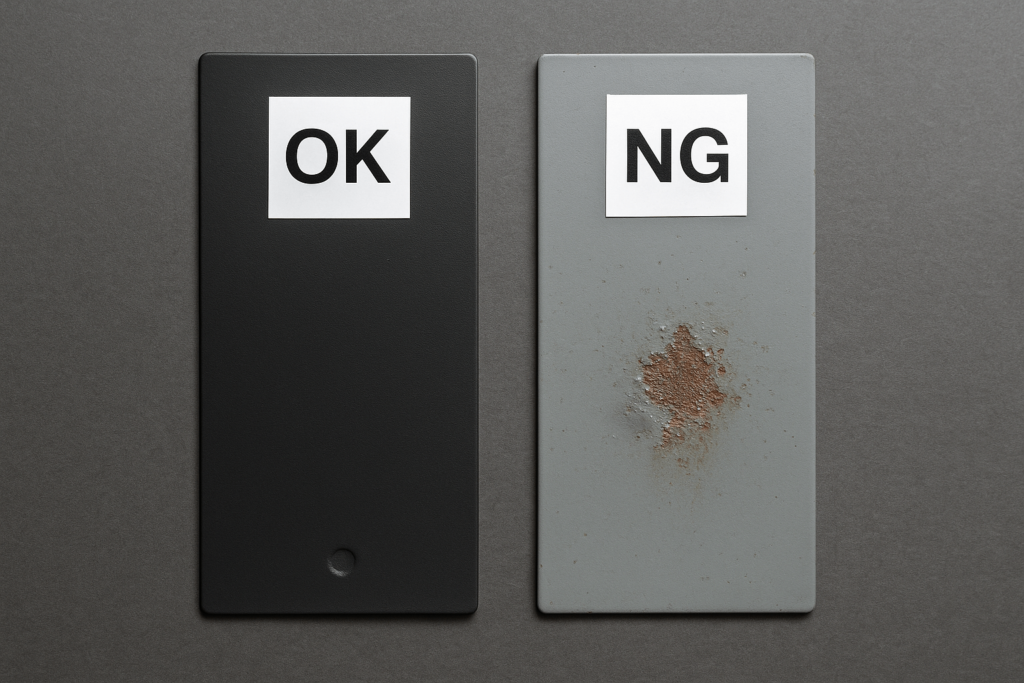
2.2 Arena 2: The Beauty Contest — Color Matching & Film Thickness
While durability drives performance, aesthetics drive marketability. This is a trade-off between consistency and flexibility. A key difference lies in coating thickness.
Powder coating struggles with ultra-thin applications—sub-1.5 mils often yield orange peel textures. Wet paint, in contrast, can achieve smooth, even films under 1 mil (25 microns)—ideal for precise, interlocking parts.
Color control is also critical. Wet paint enables precise, small-batch color matching—even Pantone shades—mixed on-site. Powder coating offers thousands of RAL colors, but custom shades require special batching, larger MOQs, and longer lead times.
For ultra-high-gloss finishes (e.g., automotive exteriors), wet paint remains unmatched. Powder coating excels in durable, textured finishes that can mask minor substrate imperfections—ideal for fabricated sheet metal parts.
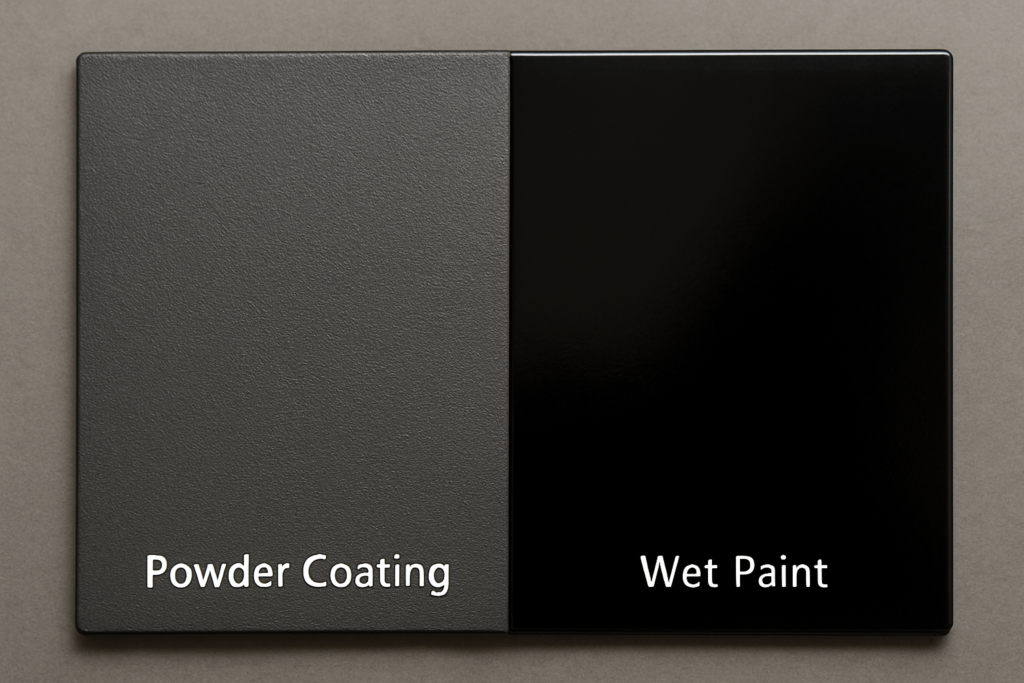
2.3 Arena 3: The Price of Perfection — TCO and Operational Throughput
A surface-level powder coating vs paint cost comparison is misleading. True cost clarity comes from Total Cost of Ownership (TCO)—essential for wholesale buyers.
While wet paint lines have lower initial CapEx, ongoing OpEx may be higher due to ventilation, solvent control, and environmental compliance.
Material efficiency is powder coating’s biggest edge. Its reclaimable overspray enables up to 98% utilization. Wet paint yields only 30–50%, wasting material and incurring hazardous disposal costs.
Automation further boosts powder coating efficiency. One-coat application and rapid curing (often under 30 minutes) increase throughput. Wet painting requires more steps and drying time, slowing production.
For high-volume jobs, powder coating offers lower TCO and faster time-to-market.
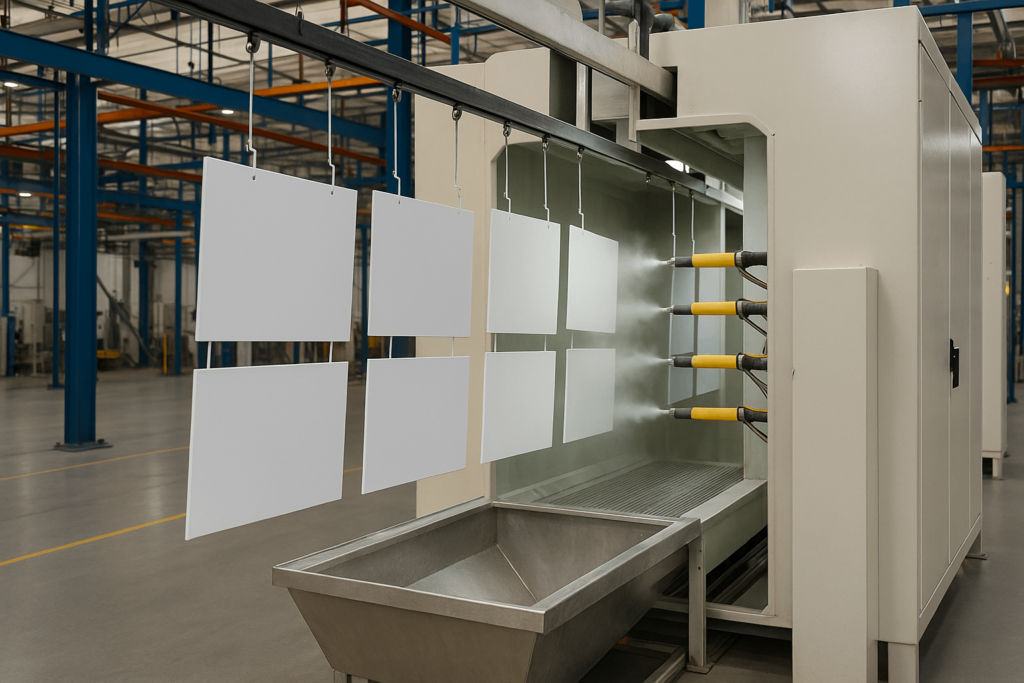
2.4 Arena 4: The Green Gauntlet — VOCs, Waste & Compliance
EHS (Environmental, Health, and Safety) performance is now a business imperative. Powder coating has a clear advantage in environmental impact, recognized by the EPA.
It emits negligible VOCs, unlike solvent-heavy wet paints. With no solvents, powder coating simplifies air compliance.
Wet painting produces hazardous waste from overspray and solvent cleaning—requiring costly disposal. Powder coating generates minimal, often non-hazardous waste, making it more sustainable.
Operational safety is also improved. Wet painting involves flammable, toxic solvents. Powder coating’s main hazard is dust, manageable with PPE. Powder-based operations are generally safer and more compliant.
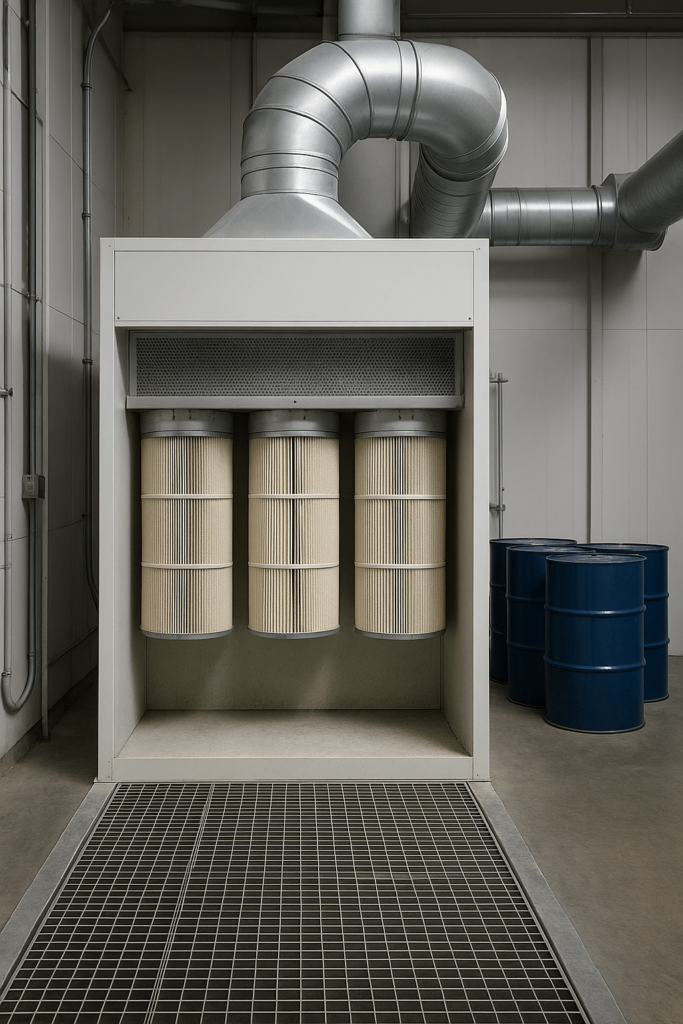
2.5 Arena 5: The Application Maze — Process & Real-World Fit
All coatings rely on proper pretreatment. Failures typically stem from poor surface prep, not coating breakdown.
Multi-stage pretreatment (alkaline cleaning, rinsing, conversion coating) ensures adhesion.
Powder coating uses electrostatic spraying for excellent coverage. However, the Faraday cage effect makes inner corners hard to coat. Mitigation includes using Tribo guns or adjusting spray parameters.
Wet painting relies on atomization—a skilled process prone to defects like sagging or orange peel if misapplied. It’s less forgiving and requires experienced technicians. Powder coating also requires expertise but is easier to automate in industrial workflows.
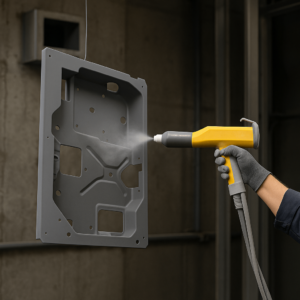
3. Myth vs. Reality: Debunking 4 Common Finishing Misconceptions
We aim to dispel frequent misconceptions:
- Myth 1: “Powder coating is always more expensive.” TCO often favors powder for high-volume runs due to efficiency and waste savings.
- Myth 2: “Wet paint is always toxic.” Not always—waterborne paints have reduced VOCs significantly and can rival powder coating’s eco-profile.
- Myth 3: “No custom colors with powder.” Custom is possible but requires batching, larger MOQs, and longer lead times.
- Myth 4: “Powder can’t be repaired.” Field repair is difficult, but not impossible. Wet paint remains better for onsite touch-ups.
4. Scenario as King: 4 Real-World Industry Cases to Guide Your Choice
Scenario 1: Architectural / Marine
- Need: Long-term weather and UV resistance
- Solution: Powder (superdurable) or PVDF liquid (AAMA 2604/2605)
Scenario 2: Electronics / Enclosures
- Need: Thin film, heat sensitivity
- Solution: Wet paint only (<25 microns, lower temp tolerance)
Scenario 3: Medical Devices
- Need: Sterilization, hygiene
- Solution: Powder, seamless, antimicrobial options available
Scenario 4: Automotive
- Need: Chassis = chip resistance, Body = gloss finish
- Solution: Powder for chassis; multi-stage wet paint for exteriors; powder epoxy for EV battery enclosures
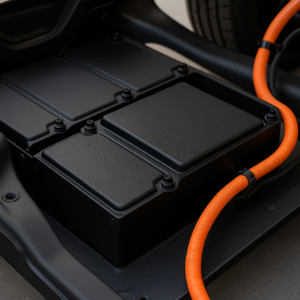
5. Future-Proof Your Finish: What’s Next on the Horizon?
Innovation is bridging the gap:
- LTC & UV-cure powder coatings now allow lower-temp substrates (MDF, plastics)
- Waterborne wet paints reduce VOCs with little performance loss

6. Final Decision Checklist & FAQ
Use this checklist:
- Need extreme durability? → Powder
- Tight tolerances or <50µm? → Wet paint
- Precise colors or small batches? → Wet paint
- Heat-sensitive parts? → Wet paint
- High throughput? → Powder
- Minimize VOCs/waste? → Powder
- Onsite repairs? → Wet paint
FAQ
- Designing for powder coating? Use radii on corners; avoid deep recesses; include hanging holes.
- Turnaround time difference? Powder <1hr; wet paint = multiple hours/days.
- Can you coat over old finishes? Not ideal. Strip first.
- RAL vs. Pantone for color? Wet paint matches both easily. Powder = RAL standard; Pantone needs custom batch.
- Food-grade safety? Yes—specify FDA-compliant powders.
For project-specific technical consultation, contact the YISHANG engineering team.

